Posts Tagged ‘Rebecca Schmid’
Friday, February 8th, 2013
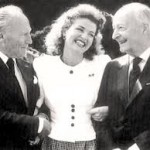
By Rebecca Schmid
The Berlin Philharmonic is celebrating the centenary of Lutosławski with several concerts this month. The first of the series on February 7—featuring his Concert for Orchestra—opened appropriately with Anne-Sophie Mutter, who premiered one of his most important works, Chain Two, in 1988. In an interview I conducted two years ago, the violinist recalled how seeing the score triggered a passion for contemporary music which she continues to nurture. Her appearance at the Philharmonie alongside guest conductor Manfred Honeck took an unrelated historic twist with a performance of Dvořák’s Romance in F-minor, although the Czech composer’s innovative integration of folk music can be seen to have foreshadowed composers such as Bartok and Lutosławski. The last violinist to perform this work with the Philharmonic is Carl Flesch, in 1909. As Mutter also explained to me, she considers herself a kind of ‘great-grandchild’ of the legendary violinist given that Flesch taught her mentor Aida Stücki.
The Romance is derived from the slow movement of Dvořák’s String Quartet in F-minor, with a main melody so melting one understands why the composer was tempted to repurpose it. He gives it a short fugal exposition in the orchestra before the violin enters, wrought well by the transparent timbre of the Philharmonic’s strings, although the sound was tense during later fortissimo passages. Mutter brings a crying quality to her high notes which pushed the Romantic emotion to the edge, and struck a mix of strength and fragility in the cantabile lines, yet the tempo was slightly pressed. The pacing was more solid for Dvořák’s Violin Concerto, and the orchestra warmed up to a more communal sound in tutti episodes. Honeck’s conducting remained deferential, if not slightly meek, but clear. Mutter and the orchestra gave the fast opening movement a glowing but icy sheen, while the inner Adagio swooned with more sentimentality. The final Allegro giocoso was the most exciting. Mutter carved out melodies with the sweet but slick tone that has inspired composers from Rihm to Penderecki, and Honeck brought out the folksy rhythms with natural flair.
Folklore plays an equally important role in Lutosławski’s Concert for Orchestra, which effectively established him as a generation’s leading composer in 1950s Poland. Its rigorous yet experimental development of tonality and rich orchestration certainly qualify it as a modernist masterpiece that deserves to be heard more often in concert halls. The instrumentation of his Concert is full of delicious subtlety, such as a piccolo solo that moves through a dissolving circle of fifths above swirling winds and strings in the inner Capriccio. But it is the final Passacaglia, Toccata e Corale that, for this listener, captures Lutosławski’s genius, with a bass line that is passed through monumental brass to the middle of the orchestra before the outer voices come crashing against it. The violins are left with the melody, a remnant of a culture that once was, against a jarring piano chord as the rest of the orchestra dies. Once the music comes back to life, the counterpoint locks into clockwork before dismantling like a cubist painting (I thought of the Czech artist Bohumil Kubista, a member of the New Secession movement), with dark, atmospheric colors that overcome angst with their own sense of order. Honeck led the work with spirit and spontaneity, and the Philharmonic responded with smooth precision.
rebeccaschmid.info
Tags:Anne-Sophie Mutter, Antonin Dvorak, Berlin Philharmonic, Bohumil Kubista, Carl Flesch, Chain Two, Manfred Honeck, Penderecki, Rebecca Schmid, Rihm, Witold Lutoslawski
Posted in Berlin Times | Comments Closed
Friday, February 1st, 2013

By Rebecca Schmid
Richard Wagner has managed to slowly dominate the scene internationally in recent seasons, but with the official arrival of his bicentenary, the saturation in Germany has only begun. Nürnberg, Leipzig, Munich and Dresden have unveiled new exhibits; in the latter’s case, an entire new building. A stream of publications has hit the market, leading Nike Wagner—rebellious daughter of Wieland, one-time bidder for the Bayreuth Festival upon Wolfgang’s resignation—to point her finger at the ‘tsunami-like influx’ (NB: her book Über Wagner comes out February 20). And then there’s the 15-hour opera. Klaus Zehelein, president of the Deutscher Bühnenverein (German Stage Association), called for a moratorium on Ring cycles last June. ‘We should leave the work alone, ideally worldwide,’ he said, denouncing centenary programming as a series of ‘encyclopedic events without artistic relevance.’
In what may be an attempt to provide an antidote, the exhibit, lecture and stage production series Wagner 2013 Künstlerpositionen at Berlin’s Akademie der Künste has set out to grapple with the German master’s polarizing effect and his place in artists’ lives, from painters to contemporary composers. A spokesperson explained that the concept arose from the international enthusiasm for Wagner and was intended to take place prior to this year. Why that didn’t happen is anyone’s guess. On January 27 the academy invited four composers and academy initiates of different generations—Dieter Schnebel, Erhard Grosskopf, Manos Tsangaris, and Enno Poppe—to discuss their relationships to Wagner in the same hall that is exhibiting the legendary rat costumes from Hans Neuenfels’ 2010 production of Lohengrin in Bayreuth.
Musicologist and moderator Jürg Stenzl opened the dialogue with a quote from Pierre Boulez, who declared Wagner ‘forgotten music’ for his generation and invited the composers to express their views on the issue. Schnebel, born in 1930, admitted that he had been corrupted as a child of Nazi times and, upon re-listening to Tristan post-war, couldn’t resist. His Wagner-Idyll (1980), for soprano and chamber orchestra, reworks the lines of Gurnemanz, the veteran knight in Parsifal, into Sprechgesang for a mezzo-soprano—naturally a subversive use of the material. At the other end of the spectrum, Poppe considers Wagner a ‘historical phenomenon,’ much as he considers Nazi Germany part of the past.
None of the composers stated they could ‘believe’ in Wagner. He is too ambiguous, a man who works with symbols, said Schnebel, as opposed to Verdi, whose operas he considers ‘clear cut’ and ‘music of reality.’ This is a fair assessment, although morality is far from clear cut in an opera such as La Traviata (based on the life of the singer Giuseppina Strepponi, whom the composer married). Nor is it true that Verdi didn’t work with symbols—he used entire allegories. The Jewish people in Nabucco represent Italians fighting for liberation from the Hapsburg Empire; the title character of Rigoletto is a disguised king.
Stenzl ended the discussion with a quote from Mauricio Kagel who, upon Beethoven’s centenary, suggested that there be a hiatus from his music for an entire year so that ‘we could then look forward to January 1’ (for a hilarious commentary of the mania around Beethoven, see Kagel’s film Ludwig Van). Tsangaris suggested that, contrary to Cage—who was feted for an entire year at the Akademie der Künste last year—there is already enough interest in Wagner from the public at large (perhaps the academy should have taken up the centenaries of Britten and Lutoslawski instead?). Poppe joked that we will need a ten year break from the Ring because the singers will have to recover their voices.
By many accounts, the music world is already weary. In New York, Robert Lepage’s colossal, machine-generated cycle has provoked a scandal of seemingly irreparable proportions. In Berlin resentment has long been brewing over a tetralogy that the Staatsoper mounted in co-production with La Scala, yielding a light, futuristic aesthetic that one critic likened to a Star Wars film. Meanwhile, in Milan, the decision to open the season with a new Lohengrin by Claus Guth was more than enough to leave national pride wounded in a country where people sing along to the ‘Brindisi’ on New Year’s Day. Still, few can ward off an endless fascination for Wagner, even if it necessitates psychiatric support (as Simon Rattle recently joked in an interview with Die Zeit). For better or for worse, we will be wandering the dark forests of myth for the next year.
rebeccaschmid.info
Tags:Akademie der Künste, Berlin, Die Zeit, Enno Poppe, Erhard Grosskopf, Giuseppe Verdi, Giuseppina Strepponi, Jürg Stenzl, Klaus Zehelein, La Scala, Manos Tsangaris, Mauricio Kagel, Nabucco, Nike Wagner, parsifal, Rebecca Schmid, richard wagner, Rigoletto, robert lepage, Schnebel, Simon Rattle, Star Wars, Tristan
Posted in Berlin Times | Comments Closed
Friday, January 25th, 2013
 By Rebecca Schmid
By Rebecca Schmid
It hardly needs to be said that contemporary music enjoys a privileged status in Germany. Even with the heavily protested merger of the SWR (Southwest German Radio) Orchestras currently in effect, the support of public broadcasting for cutting-edge programming everywhere from Donaueschingen to ‘poor but sexy’ Berlin creates an atmosphere of seemingly boundless experimentation. The annual Ultraschall Festival, co-presented by Berlin’s two major classical radio stations, Deutschlandradio and Kulturradio RBB, sets out to provide a glimpse into the wide spectrum of developments, consciously elevating adventure above dramaturgical unity.
The event, whose moderated concerts often strike a decidedly academic tone, moved into clubs for the first time this year, hosting the Ensemble Modern at the FritzClub on January 24. Despite the dark, underground aesthetic of the brick-walled space, the atmosphere departed little from that of a traditional concert save for the occasional clink of a wine glass. Most of the audience sat nearly motionless in rapt attention. The turn-out was also not particularly young, debunking theories that orchestras’ core subscribers have an aversion to anything after Stravinsky. But then again, this is Berlin.
The evening included the German premiere of Warm-up for horn and percussion by Vito Žuraj, one of many successful Wolfgang Rihm students on the scene. The work had its world premiere for the composer’s 60th birthday in Ljubljana last year and, true to its title, is intended as a prelude to Žuraj’s Horn Concerto which will have its premiere in 2014 under the baton of Matthias Pintscher. Žuraj exploits a breadth of muted, often ghostly timbres on the solo instrument to expressive effect, underscored by whirring, overlapping percussion rhythms that require coordination by a conductor (Erik Charles Nielsen). Hornist Saar Berger, with whom the composer collaborated in writing the piece, imbued every attack and line with meaning.
The solo flute work Aura by the late Emmanuel Nunes, here performed by Dietmar Wiesner, is a more introspective soliloquy but similarly exploits extreme ranges of the instrument, from fluttering to abrasive lip stops, while following a limited harmonic scheme. The most gripping work of the evening for this listener was the solo piano work Kaspars Tanz by Hanspeter Kyburz, a reflection on the life of Kaspar Hauser, an 19th century legend whose tragic existence following his upbringing in a cell has inspired poetry, opera and film. The composer juxtaposes exultant runs of freedom with dark clusters evoking his isolation, achieving a structured outpouring of emotion. Ueli Wiget brought the drama to life through an energetic, insightful performance.
An important tenet of Ultraschall is also the championing of young composers. In tribute to this year’s focus on Franco-German exchange, a concert at the Volksbühne at Rosa-Luxemburg Platz on January 24 featured the ensemble mosaik in winning compositions from a competition launched by the Lyon-based initiative ‘New Forum—Jeune Création.’ Inventive uses of live and electronic sound ranged from Christopher Trapani’s dreamscape of samples and lyrical textures in Five out of Six, set to conceptual video by Things Happen, to the alternation of a visceral, techno-derived pulse and a violin-cello duo that desperately bowed to the same heartbeat-like rhythm in Aurélio Edler-Copes’ For Malevich.
The star of the evening from the audience’s view and in terms of pure shock value was Johannes Kreidler. The young German composer, winner of last year’s coveted Kranichsteiner Prize, has earned the standing of an ‘Aktionskünstler,’ making headlines in The New Yorker when he smashed a pair of model string instruments in protest against the merger of the SWR orchestras last fall. His work Fremdarbeit¸ originally performed in 2009 at Klangwerkstatt Berlin, sets out to take issue with exploitation and copyright in a globalized, digital age. The composer commissioned a Chinese composer and Indian programmer to remix, or ‘plagiarize,’ his pre-existing composition windowed 1 that itself integrates samples.
The composer moderates the work with a mix of cutting social criticism and detached irony. ‘Most of Xiang’s music is commissioned for weddings and funerals by U.S.-Americans,’ he says. ‘But he agreed to this for $30.’ The result of programmer Murrabay’s computer manipulation yields a pointillist version out of which he provided Kreidler with an exact break-down of volume ratios and musical patterns. It is impossible to restrain laughs when the composer narrates this back to the audience in utter seriousness, although one can’t help but wonder to what extent Kreidler is unaware of the exploitation in which he is himself indulging. His activism stays as close to the surface as the saccharine pop music he quotes, an illusion of human progress that is ultimately absorbed in its own vain post-modernist conquest.
rebeccaschmid.info
Tags:Aurélio Edler-Copes, Berlin Times, Christopher Trapani, Deutschlandradio, Dietmar Wiesner, Emmanuel Nunes, Ensemble Modern, Erik Charles Nielsen, FritzClub, Hanspeter Kyburz, Johannes Kreidler, Kaspar Hauser, Kulturradio RBB, Matthias Pintscher, New Forum—Jeune Création, Rebecca Schmid, Saar Berger, The New Yorker, Ultraschall Festival, Vito Žuraj, Wolfgang Rihm
Posted in Berlin Times | Comments Closed
Sunday, January 20th, 2013
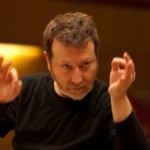
By Rebecca Schmid
Berlin may be the capital residence for young composers today, and no other time of year makes this more apparent than the Ultraschall Festival for New Music. They gathered in strong numbers during freezing temperatures for a concert on January 19 at the Haus des Rundfunks, where Brad Lubman led the Deutsches Symphonie-Orchester in works by Johannes Maria Staud, Michael Jarell, Chaya Chernowin and Georg Friedrich Haas—only the last of whom was not present because he is moving to New York. The concert was moderated by Co-Intendant Magarete Zander, a broadcaster with Kulturradio RBB which co-hosts with the festival with the former West Berlin station Deutschlandradiokultur.
Staud, a young Austrian composer and former student of Jarell whose commissions include works for both the Berlin and Vienna Philharmonic, mentioned in onstage discussion how unusual it was to be programmed back-to-back with one’s teacher. His work Contrebande (On Comparative Meterology II), which premiered with the Cleveland Orchestra in 2010, reveals the influence of Jarell in its non-conformist language and ability to narrate through intricate orchestration. Staud takes the listener’s hand through this approximately 18-minute series of miniatures based on excerpts from a Der andere Herbst by the Polish-Jewish writer Bruno Schulz, exploiting the full orchestra with melodies that are tossed organically between sections and textures from piano clusters to hollow blows that do not exist for their own sake but to build an inner drama.
Jarell, when asked about mentoring his students, said that a composer has no choice but to be an honest with himself—a precept that is more obvious in theory than practice. The Swiss native’s Sillages—Congruences II for flute, oboe and clarinet and orchestra (2005), originally conceived for flutist Emmanuel Pahud, clarinettist Paul Meyer and oboist François Leleux, undertakes a sonic exploration of rippling water that draws inspiration from the artist Alberto Giacometti. With this in mind, the first section of the approximately 26-minute work moves mystically through space like the sculptor’s signature figures that stretch their bodies inexorably toward heaven. The trio, performed by ensemble recherche, twitters above an atmospheric orchestra, breaking still surfaces. The second part recalls Jarell’s Flute Concerto for Pahud in its frenzied dialogue, creating tremendous tension that is resolved in the leading winds.
Chernowin’s The Quiet (2010) similarly moves from whispering, creaking and muted percussion that evoke the beginning of a snowstorm until the bassoons and double bassoons break through the surface and usher in an ominous swarm of musical ideas—an avalanche turned upside down, in the composer’s words. The most haunting work of the evening was Haas’ …sodaß ich’s hernach mit einem Blick gleichsam wie ein schönes Bild…im Geist übersehe for chamber string ensemble (1990/91), inspired by a W.A. Mozart letter about the act of transforming an idea into a finished work. Fragments from the Sonata for Violin and Piano in B-Major (KV 454) emerge like ghosts out of an extended stretch of subdued squeals, pizzicato, and col legno strokes before receding again into emptiness. One could almost see the glow of the melodies as they unfurled—so fleeting that one could not catch them—before the strings resumed their relentless search.
Lubman, asked by Zander if one could find such a program in the U.S., could only laugh. “In the U.S.?” he asked rhetorically, explaining that smaller ensembles dominate the scene. A concert of purely contemporary orchestra music was a non-existent breed, he said, praising Germany for the value it places on culture. Of course, the history is not so simple. The Deutsches Symphonie-Orchester, founded in 1946 by Radio in the American Sector (RIAS), is one of several broadcast orchestras erected under American reconstruction after World War Two. The many composers who flock over the pond are, depending on one’s view, returning to their roots.
As it happens, Ultraschall’s official motto this year is to celebrate the exchange of ideas between France and Germany, once warring nations who signed the Elysée Treaty fifty years ago this month. The narrative of ‘internationality’ having come to dominate many artists’ identities, the theme can be stretched to showcase a wide range of composers—which is exactly what the festival does best. I just wonder how the Geneva-born Jarell fits into the spectrum of Franco-Allemand fraternity (Vive la Neutralité)…
Stay tuned for more on the Ultraschall Festival (January 17-27).
rebeccaschmid.info
Tags:Berlin, Berlin Times, Brad Lubman, Bruno Schulz, Chaya Chernowin, cleveland orchestra, Deutsches Symphonie-Orchester, Deutschlandradiokultur, Georg Friedrich Haas, Kulturradio RBB, Magarete Zander, Maria Staud, Michael Jarell, musical america, Rebecca Schmid, Ultraschall Festival, W.A. Mozart
Posted in Berlin Times, Uncategorized | Comments Closed
Friday, January 11th, 2013
 By Rebecca Schmid
By Rebecca Schmid
Journeys have provided powerful inspiration to writers, painters and composers alike, opening eyes to new ways of seeing the world. The broadening of artists’ palettes has sometimes allowed them to capture a landscape more vividly than the natives could themselves. One only has to think of Dvorak’s New World Symphony, Gauguin’s portraits of French Polynesia (colonialist considerations aside), and—at least for an outsider— Mendelssohn’s Fourth, or Italian, Symphony. Riccardo Chailly, guest conducting the Berlin Philharmonic on January 9, juxtaposed this work with Bruckner’s Sixth Symphony, which in a similar vein was likely inspired by a trip to either Switzerland or Upper Bavaria.
Bruckner is easily the most provincial Romantic composer to have entered the symphonic canon, having rarely ventured outside his native Austria and devoting much of his opus to sacred works. Passages of the opening movement of the Sixth deviate strongly from the stormy, fretful tone one associates with his symphonies, with an exotic modal brass motive and a positively sunny melody for the violins. Program notes suggest that an underlying, one could say proto-minimalist, string texture represents the motoric drive of a train, while the trumpets herald new earthly vistas. Chailly’s vigorous, scooping gestures brought out the might of the Philharmonic.
The following Adagio brims with Mahlerian stillness, which the conductor savoured to melting effect. Even if Bruckner was not referring to the Swiss Alps, he suggests a heaven on earth that sounds very close. It is also worth noting that Mahler made several changes to the symphony before it had its first full performance in 1899, 18 years after Bruckner had completed it. By the third movement, the composer has—at least stylistically—returned closer to home terrain, with menacing blows of fate and bombastic, descending tutti passages, although there is an almost classical alternation between forte and piano sections.
The finale further vacillates between the serene and the tempestuous, with declamatory Wagnerian harmonies in the brass contrasted against delicate, protesting pizzicati and a fleeting waltz-like melody that, in the context of a journey, indicates a certain wistfulness for the fatherland. The symphony ends with a fervor that Chailly brought to a resounding close. Although the horns of the Philharmonic have even more precise on other occasions, it hardly mattered in the wider scheme of this bracing performance.
Mendelssohn’s Fourth emerged with tremendous care for dynamic contrast and shape of phrase as Chailly held thorough, but unaffected, control over the orchestra. Most impressive were the perfectly-built crescendi and decrescendi that emerged, particularly in the third movement Con moto moderato, and beautifully rounded, legato lines. Mendelssohn’s economic orchestration at times calls to mind a chamber ensemble, which the Philharmonic brought out through its characteristically tight communication between sections, particularly in the last two movements.
Concert Master of the evening Daishin Kashimoto led the violins with great precision, although the sound could have been warmer in fortissimo passages. Solo Clarinettist Andreas Ottensamer played with particular finesse in the Andante movement, characterized by sensuous, swelling lines throughout the orchestra and a touch of melancholy. True to his ‘German’ spirit, Mendelssohn does not only convey the pleasures of fine wine and sunshine but a deeply introspective, nostalgic view of the world. Perhaps this is why his symphonic portrait of Italy resonates so strongly.
rebeccaschmid.info
Tags:Andreas Ottensamer, Berlin Philharmonic, Berlin Times, bruckner, Daishin Kashimoto, Dvorak, Gauguin, Mendelssohn, musical america, Philharmonie, Rebecca Schmid, Riccardo Chailly, Switzerland
Posted in Berlin Times, Uncategorized | Comments Closed
Friday, November 30th, 2012
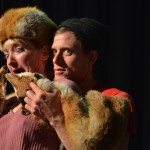 By Rebecca Schmid
By Rebecca Schmid
In the final scenes of Mahlermania, a ‘dramatic fantasy with music by Gustav Mahler’ conceived by the troupe Nico and the Navigators in cooperation with the Deutsche Oper to inaugurate the West Berlin opera house’s new alternative stage Tischlerei on November 27, manuscript paper and fur coats scatter across the stage in front of a dismembered composing hut. An actress representing Alma Mahler, donning a fur hat and trench coat, douses herself with champagne. In the midst of a chamber performance of Abschied from Das Lied von der Erde, a figure representing the alter-ego of the composer lets out a blood-curdling howl. “Es gab Mozart, Schubert,” blurts out Alma. “Damit muss man sich abfinden” (‚There was Mozart, Schubert. One was to resign oneself to it.’). The Viennese seductress is reduced to a superficial socialite when a dancer, also Alma, waves at the audience Miss America-style.
Few historical relationships lend themselves better to a theatrical realization than the tumultuous marriage of the Mahlers, ridden by the composer’s illness, his impotence alongside the ambitious Alma, and her affair with the architect Walter Gropius, not to mention the death of their first child. Mahlermania assembles a program of chamber arrangements by Anne Champert, Rainer Riehn, and Arnold Schönberg ranging from the celestial third movement of the Fourth Symphony to songs from the Knaben Wunderhorn and Rückert Lieder cycles, which are narrated with an experimental mix of dance and theater. At the center of the action is a speed-talking Alma (Annedore Kleist) whose insatiable materialism cannot be harnessed.
Gustav’s infamous sense of being “three times homeless” as a Bohemian among Austrians, an Austrian among Germans, and a Jew throughout the world is represented with suitcases, pacing, close-ups of actors in awe-struck expressions, and the lowly shack—alongside a nearly obsessive amount of furs. At one point, Kleist reveals the history of each directly to the audience, in English—“I posed in this one for Kokoschka, totally nude…1910, New York.” More effective than such indulgent sarcasm are gestures that allow the music to breathe, such as a video projection of rolling waves onto the gauze sphere surrounding the members of the Deutsche Oper orchestra during the third movement of the First Symphony.
Mezzo soprano Katarina Bradic and baritone Simon Pauly bring sensitive musicianship to Mahler’s songs and blend well dramatically, but their performances are often intercepted by failed attempts to add psychological depth, such as the dancer Anna-Luise Recke’s ravenous munching of an apple during Bradic’s earthy tones in the devastating “Ich bin der Welt abhanden gekommen” (‘I am lost to the world’) of the Rückert Lieder. A few dance episodes gain more traction, such as when the athletic Frank Willens psychoanalyzes the lithe, Sasha Waltz-inspired moves of Recke as ego-driven before scaling the bare walls of the hut, but the Freudian twist become hackneyed as Willens takes on a purely theatrical role, diagnosing Alma as he puffs on a cigarette.
Nico and the Navigators cannot be criticized for allowing tastelessness to overrun their concept, sparing the audience the nudity and fake blood that have become signatures in German theater, but the high point lies in the musical gems brought together for the occasion. Moritz Gnann and his 16-head ensemble capably evoked the composer’s brushes with death and sighs at the world’s beauty with gleaming tone in the woodwinds, even if the string section led by Detlev Grevesmühl could have benefitted from more flexible lyricism. The new Tischlerei, a generous concrete space with raked seating designed by German architect Stefan Braunfels, provided intimate acoustics.
The new stage for experimental Musiktheater, having secured support from the Berlin Senate, the pharmaceutical company Aventis, and other private sponsors, has the potential to incubate exciting collaborations in a city where the alternative scene is just starting to win the attention and funding for which it has long been fighting. In a post-performance celebration over pro secco and pretzels, young creatives mingled with the bourgeois core audience of the Deutsche Oper as well as the new Intendant Dietmar Schwarz and the city’s Culture Secretary André Schmitz. The German capital is fortunate to be booming while recession beleaguers many parts of Europe. Yet if Mahlermania stands an example of what is to come at the Tischlerei, it is the dramaturgy that will provide the biggest challenge.
rebeccaschmid.info
Tags:Alma Mahler, Anna-Luise Recke, Annedore Kleist, Deutsche Oper, Frank Willens, Gustav Mahler, Katarina Bradic, Mahlermania, Moritz Gnann, Nico and the Navigators, Rebecca Schmid, Simon Pauly, Tischlerei
Posted in Berlin Times | Comments Closed
Friday, November 23rd, 2012
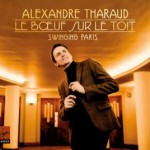
By Rebecca Schmid
The eclectic musical life of the brief but thriving ‘Roaring twenties’ continues to inspire a nostalgia that is all the more understandable given contemporary classical music’s reorientation toward popular idioms from techno to rock. The latest album of French pianist Alexandre Tharaud, Le Boeuf sur le Toit, sets out to recreate the acts of a cabaret bar that provided a hub for the cross-fertilization of jazz and classical, spawning the French expression “faire le boeuf” (to jam). Stravinsky, the members of Les Six, Picasso and Chanel count among the personalities to have hung out in the Parisian bar, named after a Cocteau-Milhaud ballet. Yet it was a little-known figure that, according to liner notes, provided the “soul of the club.” The pianist and film composer Jean Wiéner, one of the first French advocates for jazz in the aftermath of World War One, devised programs such as “concerts salades” featuring performances of Gershwin and Porter alongside the compositions of friends. The Belgian pianist Clément Doucet, who mostly made a living accompanying silent films, was a permanent fixture, joining Wiéner for four-hand routines.
Tharaud, having discovered these recordings as a young child, spent years transcribing their arrangements, for which no scores existed. He also met Wiéner at age eight. Much in the spirit of the original club, the pianist summoned several musician friends for his project, from the chanteuse Juliette to Nathalie Dessay. Frank Braley is Tharaud’s partner for the Wiéner-Doucet duos, which provide some of the album’s highlights. Gershwin’s Why do I Love You? has an infectious energy through the joie de vivre of its textures, seamlessly coordinated by the performers. Doucet’s solo riffs on works by Chopin, Liszt and Wagner also deserve to be better known. His dance-like spin on the Liebestod in Isoldina is especially refreshing in the midst of the deluge for Wagner’s bicentenary. Tharaud moves suavely from each contrasting piece of repertoire to the next, whether in the leisurely stroll of Wiéner’s Harlem, or in spritely musical theater accompaniment for Bénabar in Maurice Chevalier’s Gonna Get a Girl. The chansonnier’s French accent brings a touch of authenticity and charm to the mix. There are also homegrown musical numbers, such as an excerpt from the operetta Louis XIV featuring Guillaume Gallienne.
The ‘shimmy movement’ Caramel mou, a Cocteau-Milhaud collaboration, provides another rare gem with its fragile polytonality and lightly absurdist lyrics about taking advantage of a younger girl: “Prenez une jeunne fille/remplissez la de la glace et de gin…et rendez la à sa famille” (take a young girl/fill her up with ice cream and gin…and bring her back to her family). Jean Delescluse gives a performance conjuring the best French cabarets, with Florent Jodelet on percussion ranging from march-like snares to wood blocks evoking horse hooves. Just as priceless is Dessay’s cameo appearance in the soft, trompet-esque vocalising of Blues chanté, one of three such pieces Wiener wrote with instructions for the performer to treat the voice like a brass instrument. Madeleine Peyroux makes for a modern Ella Fitzgerald in Cole Porter’s Let’s Do It, while David Chevallier’s banjo adds spirited twang to Tharaud’s rendition of the fox trot Collegiate. It is impossible to grow tired of this album as it unfolds, with its eclectic arrangement of repertoire unified by such a tight dramaturgical arc. Wiéner’s harpsichord transcription of Saint Louis Blues by William Christopher Handy, performed on a 1959 Pleyel instrument, provides yet another surprise with its refined contours of the blues classic. Tharaud has conceived a truly original project that entertains as it illuminates this small but rich piece of musical history.
Le Boeuf sur le Toit is available for purchase on Virgin Classics.
rebeccaschmid.info
Tags:Alexandre Tharaud, Bénabar, Chanel, Clément Doucet, Cole Porter, Darius Milhaud, David Chevallier, EMI, Florent Jodelet, Frank Braley, George Gershwin, Guillaume Gallienne, Jean Cocteau, Jean Delescluse, Jean Wiéner, Juliette, Le Boeuf sur le Toit, Les Six, Madeleine Peyroux, Maurice Chevalier, Nathalie Dessay, Picasso, Pleyel, Rebecca Schmid, Stravinsky, Virgin Classics, William Christopher Handy
Posted in Berlin Times, Uncategorized | Comments Closed
Friday, November 16th, 2012
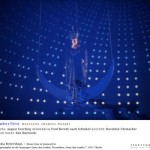 By Rebecca Schmid
By Rebecca Schmid
As Regietheater becomes the norm on opera stages in Germany, it is a pleasant, if not shocking, surprise to see a production of Die Zauberflöte that looks like a throwback to the time of its world premiere. The Staatsoper Berlin has revived a 1994 staging modelled after designs by the nineteenth-century Prussian architect and landscape painter Karl Friedrich Schinkel, primarily remembered for his Royal Theater (now rebuilt as the Konzerthaus) on Berlin’s Gendarmenmarkt. Schinkel’s sets were commissioned to commemorate the crowning of Friedrich Wilhelm I on January 18, 1816, 115 years after the inauguration of Friedrich Wilhelm I. In contrast to the production’s huge success with the audience, the prince was reportedly not pleased with the results of this investment of royal funds. “In the future I won’t mix my opinion into administration affairs,” he wrote to the General Intendant of the Royal Theater.
While stage director August Everding and his team emphasize in program notes that it would be impossible to recreate Schinkel’s vision, as we cannot travel back in time to witness certain conventions in mimic and gesture, they hope to have shed new light on Mozart’s opera in the very city that is home to Schinkel’s neo-Classical creations. The Staatsoper’s current home in the Schiller does not benefit from the 18th-century splendour of the company’s headquarters on the Boulevard unter den Linden, which are currently under renovation, but painted sets by Fred Berndt and costumes by Dorothée Uhrmacher (seen November 9) immerse the audience in an aesthetic that faithfully evoke the mythic realms of the Queen of the Night and Sarastro.
The Queen descends for her first aria on a crescent moon against a starry sky while sets representing the rocky terrain on which Prince Tamino arrives part seamlessly to the side. Sarastro’s priestdom emerges with trompe l’oeil paintings of the Egyptian-inspired architecture indicated by Mozart’s librettist, Emmanuel Schikaneder, with expert lighting by Franz Peter David to give the sets depth. In what could easily offend modern viewers, Monostatos and his gang are represented with blackface as a group of violent thugs, while the three boys first emerge with a unicorn. Surreal animals ushered in by the magic flute bring a further touch of childish charm. The feathered Papageno and the family he joins at the end of the opera also made for humorous moments, even when the libretto was doctored with contemporary gags, such as the bird catcher’s response to Tamino that they are in the Schiller Theater.
In a strange twist to the usual constellation, the evening was not as even musically as it was theatrically. The conductor Julien Salemkour, an assistant to Music Director Daniel Barenboim, gave a somewhat perfunctory performance with the Staatskapelle, often hammering out notes without enough dynamic nuance and rushing the ends of phrases. On a few occasions he also did not coordinate smoothly with the singers. The performance gained intensity and authenticity starting with the more subdued, neo-Bachian passages that usher in Tamino and Pamina’s trials through fire and water toward the end of the second act, but could have used more elasticity in the final chorus “Heil sie euch Geweihten.” Having heard the orchestra in Don Giovanni and Le Nozze di Figaro under Barenboim last season, I know the musicians are capable of better.
The visceral, legato singing of René Pape in the role of Sarastro only emphasized how much more attention to line this deceptively simple score deserves, particularly in his aria “In diesen heiligen Hallen.” Pape is surely one of the best Sarastros of his generation, if not the past century, grounding the role with solemn spirituality. The Slovakian tenor Pavol Breslik also gave a beautifully sung performance in the role of Tamino. The streetwise mannerisms of Adriane Queiroz may not have always evoked the innocence of Princess Pamina, but her lush soprano colored ensemble numbers with reliable warmth. She was also affecting in the scene in which Sarastro forbids her from taking the vengeful orders of her mother. As the Queen, Anna Siminska reliably hit the stratospheric staccato notes of her arias but struggled with intonation as she prepared for the climax of “Der Hölle Rache” and did not capture the character’s menacing seduction.
Roman Trekel animated the show with well-sculpted tones as Papageno and a keen sense of comic timing. He found a fine match in his Papagena, Narine Yeghiyan. In the role of Monostatos, Michael Smallwood was equally convincing with a clear, high lying tenor and humorous presence. The Three Women (Carola Höhn, Rowan Hellier and Anna Lapkovskaja) formed a compelling ensemble, as did the Three Boys (of the Aurelius Sängerknaben) despite difficulty following the conductor in their last scene. The guards of the pyramid (Kyungho Kim and Alina Anca) stood out among the male comprimario roles of the priestdom, and the chorus provided well-balanced singing, particularly in the second act. As mythical animals waved at the audience during the final bars, one had the feeling that Mozart and Schikaneder might approve of a production so respectful of the artistic principles that have proved their popularity with audiences time and again.
rebeccaschmid.info
Tags:Adriane Queiroz, Alina Anca, Anna Lapkovskaja, August Everding, Aurelius Sängerknaben, Carola Höhn, Daniel Barenboim, Die Zauberflöte, Emmanuel Schikaneder, Friedrich Wilhelm, Julien Salemkour, Karl Friedrich Schinkel, Konzerthaus Berlin, Kyungho Kim, Narine Yeghiyan, Pavol Breslik, Rebecca Schmid, René Pape, Roman Trekel, Rowan Hellier, Schiller Theater, Staatskapelle Berlin, Staatsoper Berlin, The Magic Flute, W.A. Mozart
Posted in Berlin Times, Uncategorized | Comments Closed
Friday, October 26th, 2012

By Rebecca Schmid
The programming of the Berlin Philharmonic, while reportedly having gravitated away from the players’ specialty in German repertoire since Sir Simon Rattle took the reins a decade ago, not only gives equal weight to post-Romantic repertoire but consistently illuminates connections between works which seem disparate at first glance. Andris Nelsons conducted the orchestra on Wednesday in a program of Britten, Widmann, Debussy and Ravel that yielded a powerful sense of emotional coherence. Jörg Widmann, a prolific German clarinettist and composer whose opera Babylon premieres in Munich next week (also featuring MA.com New Artist of the Month Anna Prohaska), combines neo-Romantic expressivity with avant-garde textures and unrestrained modern angst, much in the spirit of his teacher Wolfgang Rihm, yet in its own impulsive search. His Violin Concerto unfolds in a single, approximately 30-minute movement with a driving, lamenting melody at its center, alternately spurring and diffracting the colors of the orchestra. Structurally, it recalls Rihm works such as Gesungene Zeit, a chamber concerto written for Anne-Sophie Mutter.
Soloist Christian Tetzlaff, who premiered Widmann’s concerto in 2007, brought out the music’s direct dramatic qualities in plangent lyricism that escalates into an existential struggle richocheting throughout the orchestra. The players of the Philharmonic performed in precise coordination and with sensitivity under Nelsons. After a long pause toward the end of the piece the music returns with a violent snap in the low strings until the soloist, supported by the violins, climbs out of its tortured state. A celeste chord and gentle gong crash provide closure. This sense of eerie loneliness also penetrated the final moments opening work, the Passcaglia op.33b from the opera Peter Grimes. The soulful viola solo performed over celeste at the close, foreshadowing the death of the persecuted fisherman’s second apprentice, evokes a deserted beach and grey skies, a struggle already expired. Nelsons intelligently gave the viola section emphasis by placing it downstage in front of the celli. The aching string passages in the body of the work, punctured by anxious woodwinds, were a bit studied in this reading by the Philharmonic, but the fluid communication of the players kept the balance naturally in place.
A more lively vision of the sea emerged in Debussy’s poetic masterpiece La Mer, a series of three ‘symphonic sketches’ whose free structure and painterly landscapes have inspired everyone from Luciano Berio to John Williams. The orchestra found its stride in the second movement Jeux de vagues, capturing the music’s buoyancy with more ease than the surging, mysterious quality of the opening De l’aube à midi sur la mer, although wind solos were impeccable throughout. Nelsons brought sweep and youthful energy to Debussy’s vision of dancing waves which escalates into a battle between wind and water in the final Dialogue du vent et de la mer. The impending turbulence emerged with keen dramatic timing before subsiding into triumphant serenity. Ravel’s La Valse, conceived as a poème choréographique, follows the opposite trajectory, gathering its forces into a Viennese waltz à la Johann Strauß before marching brass attacks and Spanish-inflected castanets force the melody to fragment and spin out of control. Program notes infer that Ravel was not only impacted by the fall of the Hapsburg Empire in the First World War but the death of this mother in 1916. The strings of the Berlin Philharmonic reaffirmed their elegant culture of playing as the demonic dance unfurled with a sense of desperation that had been tacitly present the entire evening.
rebeccaschmid.info
Tags:Andris Nelsons, Anne-Sophie Mutter, Benjmain Britten, Berlin Philharmonic, Christian Tetzlaff, Claude Debussy, Johann Strauß, John Williams, Jörg Widmann, la mer, La valse, Luciano Berio, Maurice Ravel, peter grimes, Rebecca Schmid, Wolfgang Rihm
Posted in Berlin Times | Comments Closed
Friday, October 12th, 2012
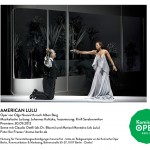
By Rebecca Schmid
The socially aware agenda of the Komische Oper’s new Intendant Barrie Kosky has been ruffling the feathers of Berliners months before he officially took over this season, not least with the decision to end the house tradition of performing operas exclusively in the German language. His emphasis on cultural pluralism aside, the program so far should assuage any fears that the native Australian will create a rupture with the opera’s hallowed emphasis on reinventing opera for contemporary audiences. Following a 12-hour Monteverdi trilogy as rescored by Elena Kats-Chernin and staged by Kosky, the intendant has unveiled the world premiere of Olga Neuwirth’s American Lulu, a shortened, updated version of Berg’s incompleted last opera.
It is either ironic or a sign of historic progress that Berlin, where Nazi politics once thwarted a full staging of the work, has mounted the second new Lulu in less than a year. The Staatsoper presented the work with a recomposed third act by David Robert Coleman last spring when a new production by Andrea Breth made it legally impossible to use the standard reconstruction by Friedrich Cerha. Almost foreshadowing Neuwirth, Coleman drew upon the jazz band of the First Act for his orchestration, thinning out textures to a chamber ensemble including marimba, steel drums cowbells, and banjo.
American Lulu (seen Oct.6) takes the thematicization of jazz a step further, setting out to reference Afro-American culture in everything from a steam blown organ ballad to a trumpet which emerges as a symbol for the blues singer, Eleanor (a curly haired, less feudal characterisation of Countess Geschwitz). Neuwirth resets passages of Berg’s original music to the first two acts for brass, woodwinds, a small set of strings, and percussion as well as electronic guitar and piano, in some places adding contours to Berg’s expressionist lines with the deeper timbres and expanding the sonic space with recorded sound. By contrast, her entirely original third act emerges as an unsure blend of quasi-minimalist textures, jazz-band brass, spectralist fades and raw, avant-garde string textures.
The English-language libretto is redevised in a similarly awkward fashion. The story begins and ends in an upscale New York apartment, traveling through New Orleans, where Lulu is living with the painter—here a photographer. Dr. Schön is instead Dr. Bloom, who kills Lulu’s lover by throwing ice at him. She flees with Bloom’s son, Jimmy (a stand-in for Alwa), becoming a high-class whore to a white banker and rebuffing the advances of Eleanor without remorse until she is killed by a stranger. Neuwirth also inserts an unidentifiable, pimp-like character named Clarence, who upbraids Lulu for being so “damn insatiable.” Recitations about black rights and other poetic musings emerge perplexingly through the speakers between acts.
The racially conscious goals of the production mostly came across as clichéd, but it had to its credit Marisol Montalvo in the role of Lulu, able to nail her high notes and move seamlessly into Sprechgesang as she cavorted in everything from lingerie to Brazilian tassels. Despite the high dose of eroticism, her dramatic portrayal did little to convey the danger of a femme fatale, which can also be attributed to the limited scope of her character in Neuwirth’s libretto and stilted direction by Kirill Serebrennikov. In the role of Eleanor, Della Miles performed with saucy poise, coaxing the orchestra of the Komische Oper into her R&B inflected grooves. The male roles were well-cast but not outstanding. Jacques-Greg Belobo gave a smooth-voiced delivery of Clarence, and Austrian baritone Claudio Otelli was an imposing Dr. Bloom. The bass Philipp Meierhöfer was in fine form as the Athlete, and Rolf Romei made for an earnest Jimmy, including when he cracked into the higher range.
German conductor Johannes Kalitzke balanced the score’s wide-ranging demands with a steady hand. Sets and costumes by Serebrennikov provided a stark backdrop for Neuwirth’s modern fantasy but ended tastelessly with a bloodied picture of a murdered Lulu. Conventional black-and-white video projections by Gonduras Jitomirksky similarly did little for a production whose progressive aspirations fail to match up with its artistic standards. Perhaps Lulu was never meant to be a vehicle for racial mobility after all.
Tags:alban berg, American Lulu, barrie kosky, Berlin, Claudio Otelli, David Robert Coleman, Della Miles, Elena Kats-Chernin, Gonduras Jitomirksky, Jacques-Greg Belobo, Johannes Kalitzke, Kirill Serebrennikov, komische oper, lulu, Marisol Montalvo, Olga Neuwirth, Philipp Meierhöfer, Rebecca Schmid, Rolf Romei
Posted in Berlin Times | Comments Closed









